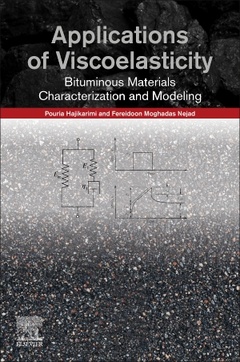Applications of Viscoelasticity Bituminous Materials Characterization and Modeling
Auteurs : Hajikarimi Pouria, Moghadas Nejad Fereidoon

Applications of Viscoelasticity: Bituminous Materials Characterization and Modeling starts with an introduction to the theory of viscoelasticity, emphasizing its importance to various applications in material characterization and modeling. It next looks at constitutive viscoelastic functions, outlines basic equations for different loading conditions, and introduces the Boltzmann superposition principle, relaxation modulus, and creep compliance. Mechanical models, including integer-order and fractional-order are studied next, featuring real experimentation data alongside the benefits and drawbacks of using each model in various real-world scenarios. The book then covers the correspondence principle, followed by time?temperature superposition, featuring a simple procedure to construct a real master curve and challenges that might be encountered. The concluding chapters cover the Hopkins and Hamming, Park and Kim, and General Power law methods for interconversion of constitutive viscoelastic functions, applications of viscoelasticity for experimental tests, and incremental form of viscoelastic relations for numerical modeling. The book also includes supplementary codes that users can duplicate and use in their own work.
2. Constitutive Viscoelastic Functions
3. Mechanical Models of Viscoelasticity
4. Correspondence Principle of Viscoelasticity
5. Time-Temperature Superposition
6. Interconversion of Constitutive Viscoelastic Functions
7. Application of Viscoelasticity for Experimental Tests
8. Incremental Form of Viscoelastic Relations
Professional engineers/R&D staff;
Prof. Fereidoon Moghadas Nejad is a well-known professor and a national figure in pavement engineering in Iran due to his high-quality research and practical works in the field of asphalt binder modification, construction of highways and railways, and concrete pavements. Additionally, he has lots of experience, and it can be said that he was the pioneer of establishing a pavement management system (PMS) in several cities of Iran. During his academic life, He supervised 10 Ph.D. dissertations and 80 master theses up to now, which resulted in more than 15 textbooks and chapters (in Persian and English), more than 190 journal papers and 200 international and national conference papers. He also contributed in 21 national and one US patents.
- Takes an applied approach to material viscoelasticity, explaining complicated viscoelastic equations and principles
- Presents examples of those equations and principles being applied to common problems in realworld settings
- Covers constitutive viscoelastic functions, including relaxation modulus and creep compliance
- Outlines the construction of a master curve of viscoelastic material considering time–temperature superposition
- Couples the correspondence principle with common viscoelastic experiments, such as threepoint bending beam, axial and torsional bar, and dynamic shear rheometer
- Provides supplementary codes
Date de parution : 04-2021
Ouvrage de 244 p.
15x22.8 cm
Thème d’Applications of Viscoelasticity :
Mots-clés :
Approximation; Arrhenius; Bending beam; Bending beam rheometer; Correspondence principle; Creep; Dynamic shear rheometer; Effective time; Elastic; Extended finite element; Finite element; Fracture mechanics; Frequency sweep test; General power law; Hopkins and Hamming; Incremental; Interconversion; Inverse Laplace transformation; Laplace transformation; Linear amplitude sweep; Master curve; Multiple stress creep and recovery; Numerical modeling; Recovery; Rotational viscosity; Semicircular bending test; Shift function; Strain; Stress; TTSP; Temperature sweep test; Time sweep test; Time–temperature superposition principle; Viscoelastic; Viscoelastic functions; Viscoelasticity; Viscous; WLF
